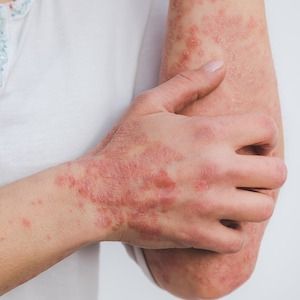News
Article
Ixekizumab Shown to be Safe, Effective for Up to 5 Years for Psoriasis
Author(s):
These data on ixekizumab in real-world settings shed light on drug survival information for both those with psoriasis and those with psoriatic arthritis.

The drug Ixekizumab is both highly efficacious and safe for up to 5 years in patients with moderate-to-severe psoriasis, according to new findings, with rapid response being predictive of patients’ long-term response and body mass index (BMI) being the main predictor of non-early achievement of the main endpoints.1
These results were indicated in a recent study conducted to assess the efficacy, survival, and safety data of ixekizumab among patients in a real-life cohort with moderate-to-severe psoriasis or psoriatic arthritis (PsA) over the course of 5 years (260 weeks).
This research was led by Luca Mastorino, MD, from the Dermatologic Clinic of the Department of Medical Sciences at the University of Turin in Italy. The drug—an immunoglobulin G subclass 4 monoclonal antibody—has previously shown strong phase-3 randomized clinical trial results with its 5-year efficacy seen in the UNCOVER-3 study.2
Nevertheless, Mastorino and colleagues noted that “Real-life data up to 5 years are still lacking; however, some works showed good effectiveness up to 3 and 4 years, with a retention rate in more than 80% of patients.”3,4
Background and Findings
The investigators used a single-center, retrospective clinical investigation which was designed to look at consecutive participants with psoriasis or PsA. They were given a minimum of 1 dose of ixekizumab and their medical records were looked at in the period between January 2017 - March 2021 at the Dermatologic Clinic of the University of Turin, Italy.
The research team used a follow-up period until April 2023. They administered the drug by implementing the standard dosing regimen typically used for those with plaque psoriasis.
The investigators’ major goals in their research covered treatment effectiveness assessment at several different points in time. Specifically, they looked at the 16, 52, 104, 156, 208, and 260 week-marks and defined their assessments with PASI100, PASI90, and PASI ≤3.
The research team also sought to examine the long-term drug survival of ixekizumab among these participants. They worked to assess possible predictive elements such as bio-naive status, mean BMI, PsA, mean age, mean onset age, non-typical psoriasis variant, visible existence of 2 or more comorbidities, previous anti-TNF alpha implementation, mean baseline PASI score, and the achievement of PASI100 by the 16-week mark which was sustained for 28 weeks.
Among the team’s secondary aims, these involved an evaluation of factors related to prediction of achieving PASI100, PASI90, and PASI ≤3 at each of the established time points. These elements included mean age, sex, difficult site involvement, bio-naive status, mean BMI, mean age of onset, having classic plaque psoriasis, PsA, baseline mean PASI, existence at least 2 comorbidities, implementation of prior traditional systemic therapies, and Dermatology Life Quality Index (DLQI) questions.
The investigators also looked at mean PASI scores and DLQI at specified periods (16, 52, and 104 weeks). They examined participants for adverse events (AEs) in terms of number and type, and pointed out any visible reasons for discontinuation of the drug.
The team reported that, at the 260-week mark, there was a drug survival rate of 65.5% among the subjects of the study, adding that those labeled as super-responders showed a diminished risk of treatment termination.
They found that the percentages of those who were shown to reach PASI100, PASI90, and PASI ≤3 at the 16-week mark were shown to be 54.1%, 60.5%, and 73%, respectively. This increased to 59.1%, 81.8%, and 95.5%, respectively, by the end of the 5-year study.
A higher mean BMI was also shown by the investigators to have been the sole factor substantially linked to decreased likelihood of the achievement of these outcomes by earlier time points. These included PASI100 and PASI90 at the 16-week and 104-week marks and PASI ≤3 at 104 weeks, with odds ratios ranging from 0.86 to 0.94.
The research team also reported that there were not any severe adverse events seen throughout the course of their study.
“Ixekizumab showed high effectiveness and safety for up to 5 years, with survival of 2/3 of treated patients,” they wrote. “Rapid response to treatment is predictive of long-term response. Only increased mean BMI results in lower treatment efficacy. Discontinuation was mostly referable to primary and secondary failure of therapy.”
References
- Mastorino L., Dapavo P., Burzi L., Rosset F., Giunipero di Corteranzo I., Leo F., et al. Drug survival, effectiveness and safety of ixekizumab for moderate-to-severe psoriasis up to 5 years. J Eur Acad Dermatol Venereol. 2023; 00: 1–8. https://doi.org/10.1111/jdv.19682.
- Blauvelt A, Lebwohl MG, Mabuchi T, Leung A, Garrelts A, Crane H, et al. Long-term efficacy and safety of ixekizumab: a 5-year analysis of the UNCOVER-3 randomized controlled trial. J Am Acad Dermatol. 2021; 85(2): 360–368. https://doi.org/10.1016/j.jaad.2020.11.022.
- Caldarola G, Chiricozzi A, Megna M, Dapavo P, Giunta A, Burlando M, et al. Real-life experience with ixekizumab in plaque psoriasis: a multi-center, retrospective, 3-year study. Expert Opin Biol Ther. 2023; 23(4): 365–370.
- Malagoli P, Dapavo P, Pavia G, Amoruso F, Argenziano G, Bardazzi F, et al. Real life long-term efficacy and safety of ixekizumab in moderate-to-severe psoriasis: a 192 weeks multicentric retrospective study-IL PSO (Italian landscape psoriasis). Dermatol Ther. 2022; 35(8):e15608. https://doi.org/10.1111/dth.156084.





